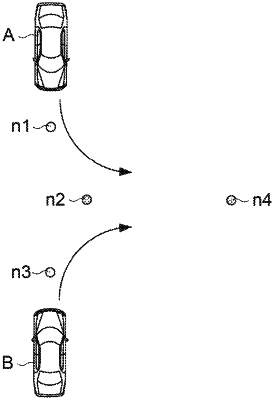| CPC G08G 1/166 (2013.01) [G01C 21/3461 (2013.01); G06Q 10/06311 (2013.01); B60W 30/06 (2013.01); G05D 1/0088 (2013.01); G05D 1/0214 (2013.01); G05D 2201/0213 (2013.01)] | 18 Claims |

|
1. An automated valet parking system to manage traveling of a plurality of vehicles by setting a scheduled passage of time for each of a plurality of nodes indicating a travel route in a parking lot, the system comprising:
a parking lot management device in wireless communication with the plurality of vehicles, the parking lot management device configured to:
calculate a travel route of each vehicle traveling in the parking lot based on a parking lot map information, the parking lot map information includes a plurality of parking lot lanes, the plurality of parking lot lanes are represented by combinations of the plurality of nodes and a plurality of links, each link of the plurality of links has information indicating a speed limit and the scheduled passage of time of each node of the plurality of nodes is set based on the speed limit of each link;
deliver route map information indicating the calculated travel route to a first autonomous driving vehicle and a second autonomous driving vehicle, the route map information includes the scheduled passage of time, which is the time when the second autonomous driving vehicle is scheduled to pass through a first node, a second node, or a third node, out of the plurality of nodes indicating the travel route;
acquire an actual passage time at which the second autonomous driving vehicle has actually passed the third node, out of the plurality of nodes indicating the travel route of the second autonomous driving vehicle;
determine a collision risk between the second autonomous driving vehicle and the first autonomous driving vehicle by comparing the actual passage time of the second autonomous driving vehicle with the scheduled passage of time of the second autonomous driving vehicle, and the first autonomous driving vehicle is scheduled to pass the second node before the second autonomous driving vehicle is scheduled to pass the second node in a predetermined passage order,
wherein
the first autonomous driving vehicle and the second autonomous driving vehicle are each scheduled to pass the second node, out of the plurality of nodes that is located forward of the third node in a traveling direction of the second autonomous driving vehicle,
delay a first scheduled passage time at which the second autonomous driving vehicle is scheduled to pass the second node and deliver the delayed first scheduled passage time to the second autonomous driving vehicle to cause the second autonomous driving vehicle to pass the second node following the first autonomous driving vehicle when it is determined that there is the collision risk and to maintain the predetermined passage order; and
manage the traveling of the first autonomous driving vehicle and the second autonomous driving vehicle based on the parking lot map information, the route map information, and the actual passage time of the first autonomous driving vehicle and the second autonomous driving vehicle,
wherein the route map information is calculated so that the second autonomous driving vehicle is scheduled to pass the second node after the first autonomous driving vehicle is scheduled to pass the second node.
|